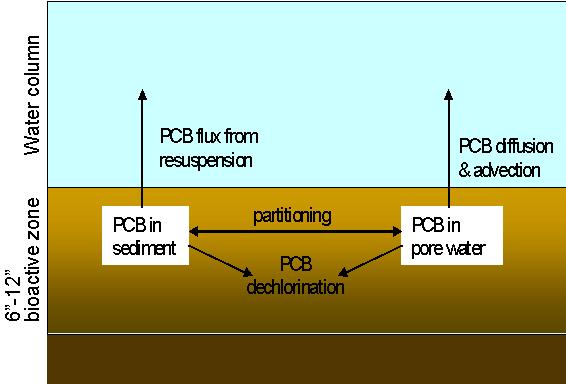|
|
Biology of Methanogenesis |
Department of Marine Biotechnology UMBC - Institute of Marine & Environmental Technology
Application of Tools to Measure PCB Microbial
Dechlorination and Flux into Water During In-situ Treatment of
Sediments

Contamination of sediments with persistent, bioaccumulative toxins such as polychlorinated biphenyls (PCBs) is a vexing problem, causing significant risk to humans and wildlife and commonly requiring expensive and disruptive remediation programs. The traditional approach is to assess risk by comparing the total contaminant concentration in the sediment to risk-based benchmarks, and to remediate sites by removing sediments for burial or treatment elsewhere. Recent studies have shown that strongly-sorbing solid phases such as soot and activated carbon present in sediment significantly reduce bioavailability of hydrophobic pollutants, such that the total measured concentration may overestimate exposure and risk. These ‘supersorbents’ may result from natural processes (fires), inadvertent anthropogenic additions (coal gas manufacturing plants), or purposeful additions for in situ remediation. This study centers around how these particles influence microbially-mediated dehalogenation reactions and dissolved-sorbed partitioning of PCBs.
The overall hypothesis is that the extent of biogeochemical reactivity and mobility of sedimentary contaminants is controlled by desorption to support dissolved concentrations. We are asking three questions: 1) What are the relationships between PCB dechlorination rates and fundamental sorption characteristics of PCBs in sediments; 2) what are the relationships between PCB flux into water and fundamental sorption characteristics of PCBs in sediment particle types; and 3) how can the enhanced understanding of PCB fate processes derived from these novel tools improve long-term risk assessments and comparison of in-situ treatment options? This study employs two new assessment tools, molecular probes for assessment of dehalogenating microbial populations and a solid phase microextraction (SPME) technique that rapidly measures truly dissolved PCB congeners in sediment suspensions, allowing desorption kinetics and bioavailability to be determined. In this study, we are using these two assessment tools to compare PCB availability to total solid phase concentrations to directly examine PCB mobility in historically contaminated sediments. Sediments are then amended with activated carbon to explore how addition of strongly sorbing solids alters microbial dehalogenation and PCB release from sediments. This approach has both fundamental and applied aspects–the activated carbon additions are tools to study PCB speciation in sediments and pilot-scale evaluations of a promising in situ remediation technique.
Many DOD
facilities face challenges from contaminated sediments, and existing
remediation options are slow and expensive. The broad goal of this project
is to assist in the development of the next generation of contaminated
sediment management tools, resulting in more efficient reduction of risk at
lower costs.
 Collaborators
Collaborators
Joel Baker, Ph.D., University of Washington - Tacoma (Project PI)
Upal Ghosh, Ph.D., University of Maryland - Baltimore County
 Project Team
Project Team
Courtney Naff
 Related Publications and Abstracts
Related Publications and Abstracts
Kjellerup, B.V., C. Naff, S.J. Edwards, U. Ghosh, J.E. Baker, K.R. Sowers. 2014. Effects of activated carbon on reductive dechlorination of PCBs by halorespiring bacteria indigenous in sediment. Wat. Res. 52: 1-10. [ABSTRACT]
Kjellerup, B.V., X. Sun, U. Ghosh, H.D. May and K.R. Sowers. Site specific microbial communities in three PCB-impacted sediments are associated with different in situ dechlorinating activities. Environ. Microbiol. 10: 1296-1309 [ABSTRACT]..
Joel Baker, Andrew Chang, Upal hosh, Piuly Paul, evin Sowers, Birthe Kjellerup. Application of Tools to Measure PCB Microbial Dechlorination and Flux into Water During In-situ Treatment of Sediments (ER-1502). The Partners in Environmental Technology Technical Sumposium & Wrikshop. December 4-6, 2007. Washington, DC.
Fagervold, S.K., H.D. May and K.R. Sowers. 2007. Microbial reductive dechlorination of Aroclor 1260 in Baltimore Harbor sediment microcosms is catalyzed by three phylotypes within the Chloroflexi. Appl. Environ. Microbiol. 73: 3009-3018 [ABSTRACT].
Schneider, A.R. and J.E. Baker (2006) The use of solid phase microextraction to rapidly measure dissolved PCBs in natural waters. Internat. J. Environ. Analyt. Chem., 86(11), 789-803.
Watts,
J.E.M., S.K. Fagervold, H.D. May and K.R.
Sowers. 2005.
A PCR based specific
assay reveals a diverse population of bacteria within the Chloroflexi
associated with the reductive dehalogenation of polychlorinated biphenyls.
Microbiology UK, 151:
2039-2046 [ABSTRACT].
Ghosh, U., J. Zimmerman, R. G. Luthy. PCB and PAH Speciation Among Particle Types in Contaminated Sediments and Effects on PAH Bioavailability.
Environ. Sci. & Technol., 37, 2209-2217, 2003.
Funded by
